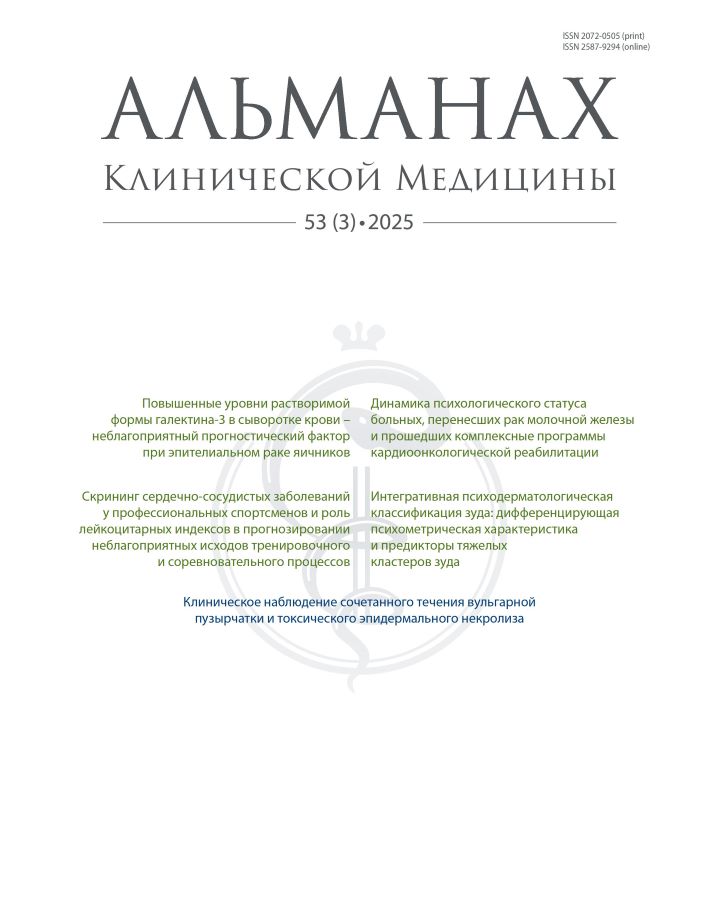СЛУЧАИ КЛИНИЧЕСКИХ ПРОЯВЛЕНИЙ СЕГМЕНТАРНЫХ ФОРМ БОЛЕЗНИ ХЕЙЛИ – ХЕЙЛИ
- Авторы: Махнева Н.В.1,2, Черныш Е.С.1,2, Белецкая Л.В.1,2
-
Учреждения:
- ГБУЗ МО «Московский областной научно-исследовательский клинический институт им. М.Ф. Владимирского»
- 129110, г. Москва, ул. Щепкина, 61/2, Российская Федерация
- Выпуск: Том 44, № 1 (2016)
- Страницы: 39-44
- Раздел: ДЕРМАТОЛОГИЯ
- Дата публикации: 15.01.2016
- URL: https://almclinmed.ru/jour/article/view/304
- DOI: https://doi.org/10.18786/2072-0505-2016-44-1-39-44
- ID: 304
Цитировать
Полный текст
Аннотация
Болезнь Хейли – Хейли (семейная доброкачественная хроническая пузырчатка Гужеро – Хейли – Хейли) – редкое кожное заболевание с аутосомно-доминантным типом наследования, характеризующееся преимущественным симметричным поражением кожи в области естественных складок. Однако встречается кар-тина сегментарного расположения очагов поражения, отражающая эпигенетический или геномный мозаицизм. Известно, что его причина – в возникновении на ранней стадии эмбриогенеза постзиготной мутации de novo как в соматических, так и зародышевых клетках. В зависимости от состояния аллельной пары гена различают 2 типа сегментарных форм аутосомно-доминантных заболеваний. В статье рассматриваются 2 клинических случая с манифестацией сегментарных форм болезни Хейли – Хейли 1-го и 2-го типов, на примере которых показано не только разнообразие клинических проявлений, но и особенности течения, прогноза передачи последующим поколениям данного генодерматоза.
Ключевые слова
Об авторах
Н. В. Махнева
ГБУЗ МО «Московский областной научно-исследовательский клинический институт им. М.Ф. Владимирского»; 129110, г. Москва, ул. Щепкина, 61/2, Российская Федерация
Автор, ответственный за переписку.
Email: makhneva@mail.ru
д-р мед. наук, профессор кафедры дерматовенерологии и дерматоонкологии факультета усовершенствования врачей
Россия
Е. С. Черныш
ГБУЗ МО «Московский областной научно-исследовательский клинический институт им. М.Ф. Владимирского»; 129110, г. Москва, ул. Щепкина, 61/2, Российская Федерация
Email: makhneva@mail.ru
аспирант кафедры дерматовенерологии и дерматоонкологии факультета усовершенствования врачей Россия
Л. В. Белецкая
ГБУЗ МО «Московский областной научно-исследовательский клинический институт им. М.Ф. Владимирского»; 129110, г. Москва, ул. Щепкина, 61/2, Российская Федерация
Email: makhneva@mail.ru
д-р мед. наук, профессор
Список литературы
- Ikeda S, Shigihara T, Mayuzumi N, Yu X, Ogawa H. Mutations of ATP2C1 in Japanese patients with Hailey-Hailey disease: intrafamilial and interfamilial phenotype variations and lack of correlation with mutation patterns. J Invest Dermatol. 2001;117(6):1654–6.
- Hu Z, Bonifas JM, Beech J, Bench G, Shigihara T, Ogawa H, Ikeda S, Mauro T, Epstein EH Jr. Mutations in ATP2C1, encoding a calcium pump, cause Hailey-Hailey disease. Nat Genet. 2000;24(1):61–5. doi: 10.1038/71701.
- Burge SM. Hailey-Hailey disease: the clinical features, response to treatment and prognosis. Br J Dermatol. 1992;126(3):275–82. doi: 10.1111/j.1365-2133.1992.tb00658.x.
- Gu H, Chang B, Chen W, Shao C. Clinical analysis of 69 patients with familial benign chronic pemphigus. Chin Med J (Engl). 1999;112(8):761–3.
- Happle R. A rule concerning the segmental manifestation of autosomal dominant skin disorders. Review of clinical examples providing evidence for dichotomous types of severity. Arch Dermatol. 1997;133(12):1505–9. doi: 10.1001/archderm.1997.03890480025004.
- Hwang LY, Lee JB, Richard G, Uitto JJ, Hsu S. Type 1 segmental manifestation of Hailey-Hailey disease. J Am Acad Dermatol. 2003;49(4):712–4. doi: 10.1067/S0190-9622(03)00847-8.
- Nanda A, Khawaja F, Al-Sabah H, Happle R. Type 2 segmental Hailey-Hailey disease with systematized bilateral arrangement. Int J Dermatol. 2014;53(4):476–8. doi: 10.1111/j.1365-4632.2012.05586.x.
- Happle R. Mosaicism in human skin. Understanding the patterns and mechanisms. Arch Dermatol. 1993;129(11):1460–70. doi: 10.1001/ archderm.1993.01680320094012.
- Biesecker LG, Spinner NB. A genomic view of mosaicism and human disease. Nat Rev Genet. 2013;14(5):307–20. doi: 10.1038/nrg3424.
- Poblete-Gutiérrez P, Wiederholt T, König A, Jugert FK, Marquardt Y, Rübben A, Merk HF, Happle R, Frank J. Allelic loss underlies type 2 segmental Hailey-Hailey disease, providing molecular confirmation of a novel genetic concept. J Clin Invest. 2004;114(10):1467–74. doi: 10.1172/JCI21791.
- Molho-Pessach V, Schaffer JV. Blaschko lines and other patterns of cutaneous mosaicism. Clin Dermatol. 2011;29(2):205–25. doi: 10.1016/j.clindermatol.2010.09.012.
- Happle R. Segmental forms of autosomal dominant skin disorders: different types of severity reflect different states of zygosity. Am J Med Genet. 1996;66(2):241–2. doi: 10.1002/ (SICI)1096-8628(19961211)66:23.0.CO;2-S.
- Siegel DH, Sybert VP. Mosaicism in genetic skin disorders. Pediatr Dermatol. 2006;23(1):87–92. doi: 10.1111/j.1525-1470.2006.00180.x.
Дополнительные файлы








